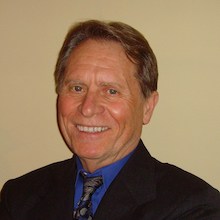
Dr. Robert Rectenwald
Advancement Through Research
Faculty: C-HOP Faculty Clinician
April 2019
C-HOP Faculty Clinician Dr. Robert Rectenwald holds a bachelor’s degree in business and even taught for several years in technical schools and community colleges. But, he says, his true passion at that time was motorcycle racing, and he thought he would be the “world champion of motorcycle racing!” However, 10 years and 22 crashes later, his chiropractor recommended to him, during one of the many times Rectenwald was there to “get put back together,” that he really should think of another line of work. His doctor, ever wanting to expand the chiropractic tribe, even encouraged him to consider Chiropractic as his next move.
Doing just that, Rectenwald attended and graduated from Life Chiropractic College in 1985 and went into practice full-time for 10 years. One day a mentor of his asked if he would think about taking a job at LIFE’s clinic since the mentor’s son was attending the University and having a bit of a hard time in his clinical experience. Rectenwald obtained the part-time position but also continued to practice part-time.
Rectenwald notes that his primary responsibility in C-HOP is the supervision of the student clinicians who perform patient histories, physical examinations, chiropractic examinations and then go on to do chiropractic adjustments. He supervises each element and assesses each student on a daily basis to monitor their progress, remediate anything he sees as deficient and reteach anything that the students may have missed in their studies. And most recently, Rectenwald has been performing as the lead instructor in a research methods and design class – one that he says is of the utmost importance to the development of his students into professional chiropractors.
He says that the most important question about research is, “Why IS it important to Chiropractic?” Rectenwald says that it can only serve to greatly benefit the profession. “I wouldn’t be doing this without a passion to improve the profession with a weak point in not enough research, and I didn’t even realize that myself until I was encouraged to get into research.”
Rectenwald says that the main type of research that he has performed has been about 95% clinical outcome case studies. He feels that this type of study adds to the scientific literature that proves that chiropractic care can manage, and even improve, conditions in not only “unusual” cases, but day-to-day cases.
When prompted about what he considers “unusual,” Rectenwald cites a patient who came into his practice with the typical complaints (pain, stiffness) that chiropractors often see. However, this patient also had Bow Hunter’s Syndrome (a stroke that is caused by turning the head to the side in a forcible way – and something that Rectenwald had never heard of before) with transient vision loss and a numbness in her hands.
Rectenwald says that with anything that we do not know enough about, we need to do research and find out what we can to determine if anything might preclude the patient from being safely adjusted. As it turns out, Bow Hunter’s Syndrome is an extremely rare disease process, and there was no reference to it in chiropractic literature. He adds that the patient had previously declined being treated surgically and had decided that she would simply live with her symptoms for the rest of her life.
However, Rectenwald says that over the course of researching the syndrome and talking to colleagues, he determined that he could help since there was a real possibility that her syndrome was the result of subluxation. He reports, “We did some atypical examinations, started adjustments and just eight weeks later, she was completely free of numbness, and even the Bow Hunter’s Syndrome was gone, along with her transient vision loss.” At that point, he says there was not a single case in his research that had any chiropractic intervention involved, with all of it being medical and mostly surgical. His was the first of its type, and he feels certain that a great number of people could benefit from this type of care.
And what is the primary impact of his example? It is that current and future chiropractors will now have published proof of the benefits of Chiropractic on Bow Hunter’s Syndrome … when they do their own research. He says that he wants all chiropractic doctors to know that if they have questions about something like this, they can search the literature and find a paper to learn more about the very important element of whether the chiropractic adjustment can and should be safely administered.
Rectenwald adds, “I try to encourage my students in the research class that this is something that can be done by them without any special expertise.” For instance, he says that most medical professionals would say the only treatment for asthma is medical intervention. However, if we have “thousands of cases of chiropractic intervention that resolved asthma,” that would have an immense and everlasting impact. And it is with a smile that Rectenwald adds, “So that’s why I encourage my students to do the research for themselves. It may just advance the profession.”
LEARN MORE:
Faces of LIFE is a story campaign that showcases members of the dynamic LIFE community, including faculty/staff, students, alumni and health science professionals. Interested in being featured or nominating a candidate? E-mail LIFENews@LIFE.edu. Read more Faces of LIFE stories.

Social Media